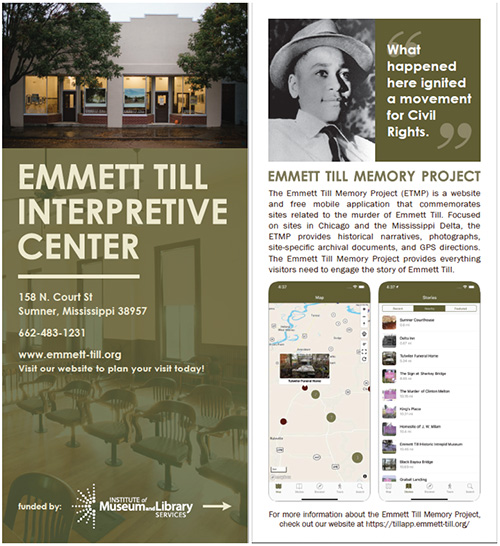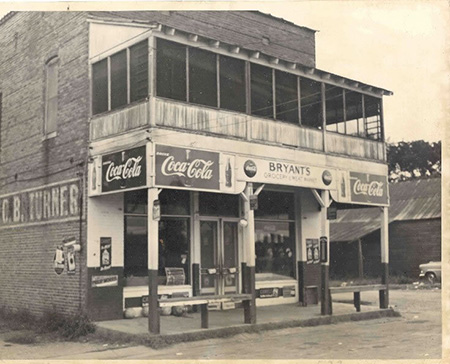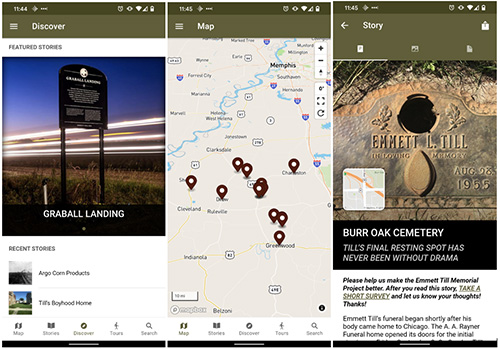Grant Spotlight | February 22, 2021
Share ThisFebruary 22, 2021

“This project is a great opportunity to build a network and consider other ways that we can share the Emmett Till story and make it relevant today.” —Elliot Long, Operations Director at the Emmett Till Interpretive Center
The 1955 murder of Emmett Till haunts American history. Till, a 14-year-old boy from Chicago, was killed in Mississippi after being accused of whistling at a white woman. More than six decades after Till’s death, people continue to try to make sense of why and how such a tragedy was allowed to take place.
To call attention to the racial injustice that Till’s death represents, the Mississippi-based Emmett Till Memorial Project created a smartphone app to guide visitors through virtual or on-site tours of 22 sites related to his murder. The app provides GPS directions to specific landmarks and offers historical and contemporary photos, narration, digital access to archival documents, social media check-ins, and historical documentary footage at each site.
The Emmett Till Memorial Project is a collaborative production of the Emmett Till Memorial Commission of Tallahatchie County and scholars across the country. With funding from the Institute of Museum and Library Services, the project team was able to build on a previous prototype of the app, refining its content and graphics and facilitating focus group testing and review by the Till family before its release.
The final result provides users with the resources they need to engage with this key moment in civil rights history—not only teaching users what happened at each site in 1955, but also how the sites have been memorialized since then.
“The project speaks to the consistent effort of our team in sharing of information pertaining to the tragedy, as well as the ongoing learning all of us are going through as we talk about race and racism,” said Benjamin Saulsbury, Museum Director at the Emmett Till Interpretive Center.
By telling Till’s story at each location—from the place he was kidnapped to the courthouse where his killers were acquitted—the app encourages users to contemplate various perspectives of Till’s story and think about how it has been retold.
Going Beyond Solving a Problem

The project began in 2014 with a meeting between the Emmett Till Interpretive Center, historians, the Till family, grant agencies, and even the FBI to discuss the ongoing vandalism of the historical sites related to Till’s death. That meeting spawned the initial idea, and it has continued to grow over the years.
In summer 2020, the project team convened to explore how they could make the app more responsive and attuned to the demographics of the Mississippi Delta.
“Having the funding to bring together the scholars of the Till story to work collectively in making a better tool and shaping the app to tell the story as accurately as we can—all while including the Till family in every step of the process—was invaluable in commemorating and remembering Emmett Till,” said Elliot Long, Operations Director at the Emmett Till Interpretive Center.
The IMLS grant funding also allowed the project team to take the app beyond Mississippi by adding Chicago sites, as recommended by the Till family.
“We went to Chicago and spent 36 hours with the Till family, who took us to the spots they felt were significant to telling Emmett’s story,” said Dave Tell, Ph.D., Professor of Communication Studies and Co-Director of the Institute for Digital Research in the Humanities at the University of Kansas. “From there, we used that narrative to add to the Emmett Till Memory Project.”
Another addition to the app is videos. The team is currently working with a film producer to develop short videos illustrating the 10 most visited sites to boost engagement and capture the history of the locations.
Telling the Story at a Critical Time

As of February 2021, the app has about 2,500 downloads.
“During the 2020 summer of racial unrest, we saw the app spike in usage—specifically in the weeks before and after George Floyd’s murder, where we saw a four-fold increase in downloads,” said Tell. “In a time where people are turning back to history, resources like those that IMLS has provided have become particularly important.”
Saulsbury agreed that the app has been a crucial tool in telling Till’s story to a broader audience in recent months. “It allows us to uplift the narrative, memory, and legacy of Till,” he said.
The COVID-19 pandemic has exacerbated the need for the app to help users visit the sites virtually or participate in self-guided tours while learning about the history of Till’s death.
“There is a lot of misinformation about the Emmett Till story, so it’s been a great way for users to look at the physical sites where things took place and have a space to contemplate different versions of the events that have been told over time,” said Long.
Shaping the Narrative for Future Generations
Although this project started as a way of marking forgotten sites, correcting misinformation, and solving logistics issues related to a lack of tour guides, it has since spurred much larger conversations about how to build commemorative infrastructure related to Till’s death and renovate the church where his funeral was held.
“It’s an ongoing project with people who still live in the shadow of these tragedies,” said Tell.
The project team members agree that the relationships built through this project have allowed them to experience what happened in a new way.
“The app has the potential to be used in a very deliberate, educational sense—be it traditional methods of learning or individual exploration. This app helps us figure out how to bridge and close gaps when it comes to the way information is shared and how people approach the Till narrative,” Saulsbury said.
In early 2021, it was announced that Till’s former South Side Chicago home has been designated as an official landmark and will be turned into a Great Migration museum to spark conversations and meaningful action against racial injustice.
Next year ABC is releasing Women of the Movement, a mini-series that focuses on Emmett Till’s mother, Mamie Till-Mobley.
About the Project
Grant Project Name: Emmett Till Memory Project
Grant Log Number: MH-00-19-0017-19
Year Awarded: 2019
Recipient: Emmett Till Memorial Commission of Tallahatchie County, Inc.
Project Contact:
Elliot Long
Operations Director
Emmett Till Interpretive Center
elliot@emmett-till.org
